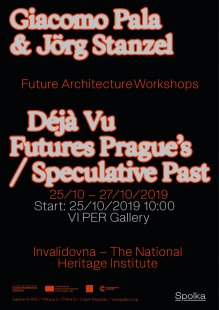
Giacomo Pala & Jörg Stanzel: Déjà Vu Futures Prague’s / Speculative Past (workshop)
Pořadatel
Galerie VI PER
Místo konání
Vítkova 2, Praha 8
Start
fri 25.10.2019 10:00
End
sun 27.10.2019 18:00
Odkaz
http://www ...
Galerie VI PER
Místo konání
Vítkova 2, Praha 8
Start
fri 25.10.2019 10:00
End
sun 27.10.2019 18:00
Odkaz
http://www ...
Workshop
Publisher
During the workshop, we will focus on the Invalidovna building, a baroque structure that in the past served as accommodation for patients recovering from war injuries and which is today empty. In light of ongoing discussions about possible uses for the building, workshop participants will create fictional narratives, imagining possible transformations of the entire complex, both in terms of its content and form. To develop such narratives, we will focus on the concept of uchronia: alternative present. We will trace the history of this place and imagine a fictional development of historical events in order to derive how the building could be used today. Just as with déjà vu, we will perceive the present as something contemporary, already experienced, but alternative to reality. The aim will be to create new forms of the future, sourcing them from the past: what it could be, rather than what it will have to be. In this sense, the building will be presented as a vessel and product of various forms of social and cultural communities. As a space where different kinds of activities could take place and which serves as an expression of various more or less fictional social conditions. Finally, during the workshop, we will speculate on the complex relationships among communities, politics, and architecture. The outcome will be a colorful map showing how space and time take different alternative paths. Workshop participants will be invited to develop their visions through collages, images, and/or drawings.
Giacomo Pala is an architect and researcher. He currently serves as a research assistant at the Institute of Theory of Architecture at the University of Innsbruck in Austria, where he is one of the leading members of the "ArchiFicture" studio under Bart Lootsmy. He is also a PhD candidate at the same university (his supervisor is Peter Trummer) focusing on the intersection of architectural theory, history, and design. Specifically, he leads research on ways of perceiving history as a nonlinear narrative that could be used as a design method – parachronism – and also as a tool for speculative reflections: a new, contemporary way of engaging with canons and mimetic references. Outside his academic career, he has also worked in several architectural firms including Coop Himmelb(l)au and co-founded the cultural association Burrasca in 2013.
Jörg Stanzel is an architect, designer, and researcher who lives and works in Innsbruck (Austria). In his current research, he explores the idea of the real and the false in the architectural world, its influence on our design methods and the interpretation of architectural objects. He graduated in 2019 under Prof. Peter Trummer at the Institute of Urbanism at the University of Innsbruck (IOUD), to whose team he joins this semester. He collaborates with design and architecture studios, such as Swarovski, developing digital tools, computational design, and visualizations. In addition to his academic interests, he has work experience from several architectural offices, including UN-Studio (Amsterdam) and GRAFT-architects (Berlin).
The workshop is part of the exhibition Spolka: Spaces of Collectivity, which can be seen at the VI PER Gallery. The workshop will be led by architects Giacomo Pala and Jörg Stanzel and will be conducted in English. The maximum number of participants is 15. Registration at spolka@spolka.cc.
Giacomo Pala is an architect and researcher. He currently serves as a research assistant at the Institute of Theory of Architecture at the University of Innsbruck in Austria, where he is one of the leading members of the "ArchiFicture" studio under Bart Lootsmy. He is also a PhD candidate at the same university (his supervisor is Peter Trummer) focusing on the intersection of architectural theory, history, and design. Specifically, he leads research on ways of perceiving history as a nonlinear narrative that could be used as a design method – parachronism – and also as a tool for speculative reflections: a new, contemporary way of engaging with canons and mimetic references. Outside his academic career, he has also worked in several architectural firms including Coop Himmelb(l)au and co-founded the cultural association Burrasca in 2013.
Jörg Stanzel is an architect, designer, and researcher who lives and works in Innsbruck (Austria). In his current research, he explores the idea of the real and the false in the architectural world, its influence on our design methods and the interpretation of architectural objects. He graduated in 2019 under Prof. Peter Trummer at the Institute of Urbanism at the University of Innsbruck (IOUD), to whose team he joins this semester. He collaborates with design and architecture studios, such as Swarovski, developing digital tools, computational design, and visualizations. In addition to his academic interests, he has work experience from several architectural offices, including UN-Studio (Amsterdam) and GRAFT-architects (Berlin).
The workshop is part of the exhibition Spolka: Spaces of Collectivity, which can be seen at the VI PER Gallery. The workshop will be led by architects Giacomo Pala and Jörg Stanzel and will be conducted in English. The maximum number of participants is 15. Registration at spolka@spolka.cc.
The English translation is powered by AI tool. Switch to Czech to view the original text source.

0 comments
add comment









